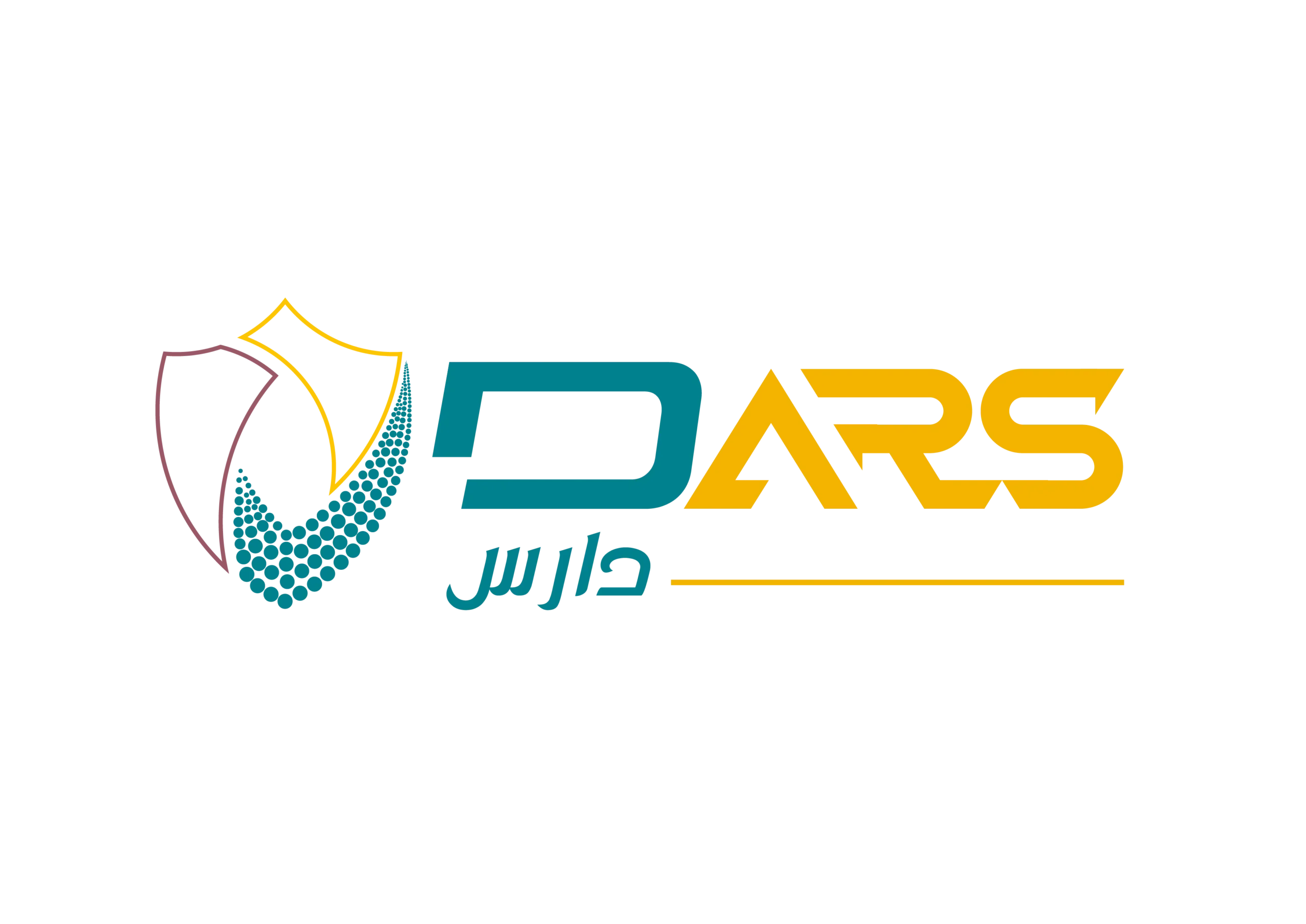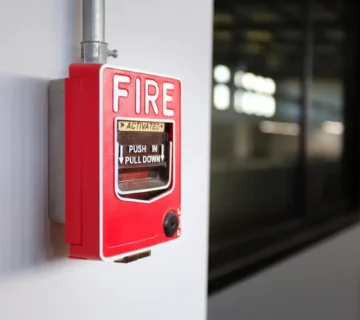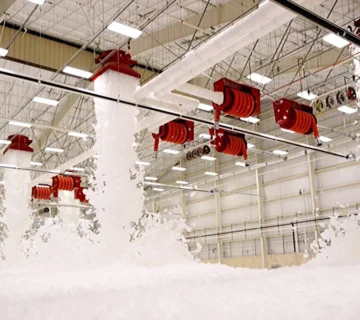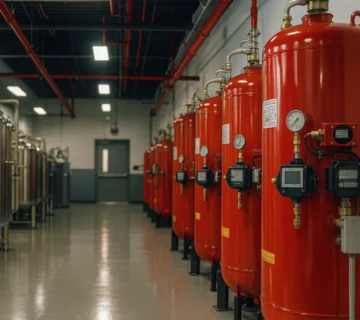Introduction
In a world where technology powers every operation, fire safety solutions have evolved from basic sprinklers to advanced systems that safeguard both people and equipment. Among the most trusted systems in this evolution stands the FM200 gas suppression system, a clean agent fire suppression solution that combines speed, safety, and reliability.
In Saudi Arabia, the demand for this technology has grown rapidly. With increasing investments in data centers, control rooms, industrial facilities, and commercial spaces, the need for automatic fire protection that complies with Saudi Civil Defense and NFPA standards compliance has become a national priority. Companies like DARS have positioned themselves as leaders in applying these systems with precision, ensuring protection that meets international standards while aligning with local safety codes.
What Is the FM200 Gas Suppression System?
The FM200 gas suppression system is a clean agent fire suppression solution that uses HFC-227ea (Heptafluoropropane) as its extinguishing agent. Unlike water-based systems, it leaves no residue and does not harm sensitive electronics or valuable documents. It works by interrupting the chemical reaction that sustains fire while cooling the surrounding area all without reducing oxygen to dangerous levels.
This balance makes FM200 one of the few systems suitable for occupied environments. It provides a rapid response without causing secondary damage, a key reason behind its widespread use in critical sectors such as data center fire protection and telecommunications.
The FM200 agent is stored as a liquid in pressurized cylinders and released as a gas through a network of discharge nozzles upon system activation. Within 10 seconds, the agent floods the protected area, extinguishing the fire before it can spread.
Why Choose FM200 Systems in Saudi Arabia?
Saudi Arabia’s infrastructure boom spanning from Vision 2030’s smart cities to high-tech industrial complexes demands reliable, high-performance fire suppression systems. The FM200 solution offers several advantages that make it particularly suited to the region’s needs:
- Safety for Occupied Spaces – FM200 is non-toxic at design concentrations, ensuring safe evacuation and no harm to personnel during discharge.
- Zero Residue and Minimal Downtime – Unlike CO₂ or water-based systems, FM200 leaves no residue, reducing downtime after a fire event.
- Compact Design and Environmental Care – It requires less storage space, offers environmental fire safety, and has zero ozone depletion potential.
As a fire extinguishing system, it provides not just protection but business continuity, a crucial factor for sectors like finance, energy, and technology. Its efficiency, clean performance, and compliance with NFPA 2001 and Saudi Civil Defense standards make it the top choice for organizations prioritizing precision and reliability.
The Core Components of an FM200 Fire Suppression System
Understanding how FM200 works starts with its components. Every system is engineered according to the room’s volume, risk type, and occupancy conditions. The primary components include:
- Cylinders: Contain the HFC-227ea agent under high pressure with nitrogen as a propellant.
- Discharge Nozzles: Evenly distribute gas throughout the room for total coverage.
- Piping Network and Valves: Custom-designed using specialized software to ensure optimal flow and timing.
- Detection and Control Panel: Monitors fire sensors and automatically activates discharge upon detecting smoke or heat.
This integration of fire suppression technology ensures that a fire is detected and extinguished before it escalates into a full-scale emergency.
Applications of FM200 Systems in Saudi Arabia
The flexibility of the FM200 system allows it to protect a diverse range of environments where traditional methods fall short. In Saudi Arabia, some of the most common installations include:
- Data Centers & Server Rooms – Protecting critical IT infrastructure where downtime equals revenue loss.
- Telecommunication Facilities – Ensuring operational continuity for national communication networks.
- Control Rooms & Power Plants – Securing sensitive equipment vital for public utilities and manufacturing operations.
- Museums & Archives – Preserving priceless cultural heritage with clean, residue-free suppression.
As technology-driven sectors expand under Vision 2030, data center fire protection has emerged as a strategic focus. Many new facilities across Riyadh, Jeddah, and Dammam now adopt FM200 systems as part of their automatic fire protection infrastructure.
Comparison: FM200 vs. CO₂ and Other Gas Systems
While CO₂ systems are effective in unoccupied industrial zones, FM200 stands apart for its safety and speed. It extinguishes fires through heat absorption and chemical inhibition, unlike CO₂, which displaces oxygen making FM200 ideal for offices and control rooms.
FM200 also offers better environmental fire safety than halon systems, which were phased out due to ozone depletion effects. Although newer agents like Novec 1230 are emerging, FM200 continues to dominate due to its extensive global certification, lower cost, and proven reliability in hot climates like Saudi Arabia’s.
Regulatory Standards and Compliance
In Saudi Arabia, the installation and maintenance of FM200 systems fall under strict guidelines from Saudi Civil Defense and SASO (Saudi Standards, Metrology and Quality Organization). Systems must be designed and tested according to NFPA 2001 standards, ensuring reliability in every activation scenario.
Certification from recognized suppliers such as HYGOOD and Ansul is mandatory for contractors implementing FM200. Firms like DARS apply a precise engineering approach, ensuring every installation meets both international safety codes and local building regulations.
The Installation Process Explained
Installing an FM200 system is not a one-size-fits-all process. It involves technical precision and customized design based on the risk category and room specifications. The installation process typically includes:
- Hazard Analysis & Site Survey – Engineers identify critical zones and determine agent quantity using calculation software.
- System Integration – Cylinders and piping networks are installed and linked to fire detection panels.
- Testing & Commissioning – Pressure and discharge tests ensure the system performs under real conditions.
Each step must be supervised by certified engineers and approved by local authorities. The design phase also incorporates room integrity testing to confirm proper gas retention time, which is vital for full total flooding system performance.
Why Businesses in Saudi Arabia Are Choosing FM200
Across sectors from financial institutions to manufacturing plants FM200 systems have become a symbol of trust and operational resilience. They ensure protection without disrupting daily operations, fulfilling both fire safety and business continuity goals.
The rise of smart buildings and automated monitoring systems has further boosted the integration of FM200 systems into larger safety ecosystems. By connecting with IoT sensors and centralized monitoring, these systems offer early alerts and quick-response mechanisms a vital edge for mission-critical operations.
Maintenance, Compliance, and Long-Term Reliability
The Importance of Proper Maintenance
A well-installed FM200 gas suppression system is only as reliable as its maintenance routine. Regular inspection, testing, and calibration ensure that the system responds instantly when needed. In Saudi Arabia, where climate conditions can challenge equipment integrity, maintenance plays an even greater role in ensuring longevity and compliance with Saudi Civil Defense regulations.
Professional maintenance involves more than checking gauges or refilling cylinders. It requires a detailed understanding of the system’s pressure levels, nozzle flow rates, and detection sensitivity. Every component from control panels to discharge piping must perform precisely as designed. At DARS, engineers conduct preventive maintenance schedules that align with NFPA standards compliance, ensuring the system’s reliability throughout its operational life.
Refilling and Recommissioning Procedures
After an FM200 system is discharged, whether in an actual fire or during testing, refilling is a critical phase that demands technical precision. The HFC-227ea agent must be refilled to exact pressure levels using certified refilling stations authorized by both local and international regulatory bodies. Failure to meet these requirements can result in performance degradation or safety risks during the next discharge.
Each refilling process begins with depressurizing and cleaning the cylinder before adding new agent and nitrogen propellant. Following that, a complete leak test ensures there are no microfractures or valve malfunctions. Once the system passes these inspections, it undergoes recommissioning where the entire network, from detection sensors to discharge nozzles, is tested in a simulated activation sequence.
This process is not merely procedural; it ensures business continuity. For mission-critical environments like data center fire protection, downtime can cost millions. Hence, companies prefer service providers that guarantee fast turnaround times and certified compliance.
Regulatory Framework and Saudi Civil Defense Compliance
Fire suppression in Saudi Arabia is governed by strict technical and legal frameworks designed to protect life, property, and infrastructure. The Saudi Civil Defense mandates that all fire suppression systems adhere to SASO standards and be installed by licensed contractors. In the case of FM200, this includes system certification under NFPA 2001, periodic inspections, and updated documentation of performance tests.
To secure approval for operation, facilities must maintain detailed records of installation, calibration, and maintenance schedules. This documentation demonstrates not only safety compliance but also the organization’s commitment to responsible operation and environmental stewardship. DARS’s engineering teams, for example, handle all regulatory coordination, ensuring smooth inspections and guaranteed compliance with both national and municipal safety codes.
Integration with Modern Fire Detection Systems
Modern FM200 setups are rarely standalone. They are integrated with advanced fire detection systems, including smoke aspirating detectors, linear heat sensors, and addressable alarm panels. This integration enhances automatic fire protection, enabling early detection and faster response. Once a potential fire is identified, the system automatically signals the release mechanism reducing the delay between detection and suppression to mere seconds.
Such responsiveness is vital for environments that handle critical operations, such as telecommunication centers or energy facilities. By connecting detection panels to building management systems (BMS), operators can monitor real-time alerts remotely, improving situational awareness and response coordination. This connectivity also supports predictive maintenance, helping teams identify potential faults before they become critical.
The Role of Technology and Data in System Optimization
The evolution of fire suppression technology has brought digital monitoring to the forefront. Today’s FM200 systems are equipped with sensors that record discharge pressures, room conditions, and agent weight in real time. This data-driven approach allows maintenance teams to detect leaks, optimize gas usage, and even forecast refill schedules before an issue arises.
Saudi businesses increasingly view fire safety as part of their digital transformation strategy. With government initiatives promoting smart infrastructure and automation, the integration of FM200 systems into IoT-based platforms reflects a shift from reactive safety to proactive asset management. Companies leveraging this approach not only protect their assets but also enhance operational resilience aligning with the Kingdom’s Vision 2030 sustainability and innovation goals.
Environmental Fire Safety and Sustainability
Although FM200 is categorized as a clean agent fire suppression solution, environmental responsibility remains a crucial topic. The agent’s chemical composition, HFC-227ea, has no ozone depletion potential, making it a preferred choice under the Montreal Protocol. However, it does possess a moderate global warming potential, which has prompted continuous research into greener alternatives.
Saudi Arabia’s sustainability commitments encourage the use of energy-efficient and environmentally responsible systems. FM200 fits this approach through efficient discharge mechanisms and controlled gas volumes, which reduce overall emissions during refilling or testing. Some facilities even integrate gas reclamation systems that capture and recycle discharged agents minimizing waste and cost simultaneously.
This commitment to environmental care reinforces FM200’s role as a practical yet responsible choice, balancing fire safety with ecological awareness.
Comparing FM200 with Newer Clean Agent Alternatives
As technology evolves, so do fire suppression agents. Alternatives such as Novec 1230 and FK-5-1-12 have entered the market, offering lower global warming potential. However, FM200 remains the leading system in Saudi Arabia due to its wide certification base, well-established infrastructure, and compatibility with existing fire extinguishing system designs.
While newer agents may appeal to projects prioritizing long-term environmental targets, FM200 still outperforms many in terms of cost-efficiency, refilling availability, and engineering familiarity. Most importantly, Saudi Civil Defense approvals and NFPA certifications for FM200 systems remain highly active and widely recognized, giving it a unique regulatory advantage.
In short, FM200’s enduring presence reflects its proven reliability. It’s not just about extinguishing fires it’s about ensuring consistency, accessibility, and compliance within a rapidly developing economy.
The Cost of Ownership and Lifecycle Value
One of the most common misconceptions about FM200 systems is that they are costly to maintain. While the initial investment may appear high, the long-term cost of ownership tells a different story. FM200’s quick activation time, minimal cleanup requirements, and low refilling frequency significantly reduce operational expenses over the system’s lifetime.
Moreover, its clean discharge minimizes damage to sensitive equipment, saving businesses from costly downtime or replacement costs. When compared to water-based suppression or CO₂ systems, FM200 provides a measurable return on investment through reduced loss, increased uptime, and lower post-incident recovery costs.
The real value lies in its reliability. Businesses know that when a fire occurs, every second counts and FM200’s proven 10-second extinguishing capability ensures that those seconds are never wasted.
Professional Servicing and Certification
In Saudi Arabia, FM200 systems must be serviced by certified professionals accredited under Saudi Civil Defense and SASO guidelines. This certification ensures technicians understand system calibration, chemical handling, and pressure regulations. Unqualified servicing not only risks safety but can also void system approval and insurance coverage.
DARS’s technical teams, for instance, are trained to meet NFPA 2001 and local compliance requirements. Their precise maintenance approach from system inspection to documentation ensures that each client maintains valid compliance certifications year after year. This meticulous process reinforces reliability, which is essential in sectors where safety failures are not an option.
Future Innovations and DARS’s Leadership
The Future of Fire Suppression Technology
As Saudi Arabia continues to modernize under Vision 2030, the field of fire suppression technology is transforming. The FM200 gas suppression system, long recognized for its balance of performance and safety, is now being integrated into broader smart safety infrastructures. These systems interact seamlessly with digital monitoring tools, enabling real-time analytics, predictive maintenance, and automatic incident reporting.
This evolution marks a shift from traditional firefighting methods toward intelligent risk management. Instead of reacting to fires, buildings can now anticipate risks. This predictive approach is becoming standard across industries such as oil and gas, logistics, and technology, where downtime is unacceptable. FM200’s adaptability ensures that it remains a foundational system within this new safety ecosystem, capable of integrating with next-generation detection frameworks and energy-efficient infrastructure.
Government Initiatives and Vision 2030 Alignment
Saudi Arabia’s national agenda emphasizes industrial safety, sustainability, and digital transformation. Fire safety compliance is no longer viewed as a regulatory checkbox but as a key pillar of responsible development. The Saudi Civil Defense, in collaboration with SASO, is continuously updating safety codes to align with NFPA standards compliance and international benchmarks.
For FM200 systems, this means new installation designs must accommodate sustainability goals, minimize emissions, and incorporate eco-conscious practices. Many industrial and commercial facilities are now required to integrate automated suppression systems as part of their operational licenses, reinforcing the importance of clean agent fire suppression in protecting both people and assets.
By meeting these requirements, organizations not only ensure safety but also contribute to the Kingdom’s reputation as a global hub for advanced, sustainable technologies. DARS has been at the forefront of this movement, bridging global standards with local expertise.
Emerging Innovations and Technological Trends
Innovation in fire suppression systems extends far beyond the chemical agents themselves. Research and development are now focused on creating hybrid systems that combine multiple suppression methods into one intelligent control network. For instance, advanced sensors can identify fire types electrical, chemical, or oil-based and activate the most effective agent instantly.
The introduction of AI-powered fire prediction models represents another major leap forward. These systems analyze temperature fluctuations, humidity, and power load patterns to detect anomalies before ignition. FM200’s rapid activation mechanism makes it ideal for integration with such smart detection technologies.
Additionally, the growing use of cloud-based monitoring platforms allows engineers to oversee hundreds of systems simultaneously. Through real-time dashboards, facility managers can assess readiness levels, check gas pressures, and receive automated maintenance alerts all of which reduce human error and improve response time.
Training, Certification, and Industry Expertise
The efficiency of FM200 systems depends not only on technology but also on people. In Saudi Arabia, the demand for certified fire safety professionals has increased substantially. Organizations are investing in regular training programs to ensure that engineers and maintenance teams understand the complex mechanisms of total flooding systems and the chemical properties of the HFC-227ea agent.
DARS plays a critical role in this professional development ecosystem. Through ongoing training and knowledge-sharing initiatives, the company ensures that safety professionals remain up to date with the latest compliance standards and technical innovations. This commitment to education reflects DARS’s belief that safety begins with awareness and expertise.
The Economic Value of Reliability
Beyond safety, FM200 systems offer significant economic benefits. In high-value sectors like data management, aviation, and energy, the cost of downtime can be devastating. A single incident of fire-related disruption can result in millions of riyals in lost productivity, data loss, or equipment replacement.
FM200’s clean and residue-free operation minimizes the risk of such losses. Its speed of extinguishment often within ten seconds means that facilities can resume operations quickly after an incident, with minimal post-discharge cleanup. The long-term financial advantage of this efficiency makes FM200 a preferred investment among Saudi enterprises seeking to safeguard not just their assets but their continuity.
For further insights on industry-specific applications, refer to Verified Market Research’s FM200 report.
The Role of DARS in Advancing Fire Safety
As one of Saudi Arabia’s trusted fire safety solutions providers, DARS has built a reputation for precision, reliability, and compliance. Its expertise extends from system design and installation to maintenance and certification, guided by a commitment to protecting lives and property in line with Civil Defense and NFPA standards.
DARS’s engineers use advanced simulation software to model gas distribution, ensuring uniform concentration across rooms of varying volumes. Their precise maintenance methodology combining automated monitoring with manual inspection reflects a balance between technology and human oversight. This meticulous approach positions the company as a partner of choice for industries seeking not only safety compliance but also peace of mind.
Moreover, DARS’s emphasis on sustainability ensures that each FM200 deployment aligns with both international best practices and Saudi Arabia’s environmental vision. From data centers to oil refineries, the company’s installations stand as testaments to engineering excellence and environmental responsibility.
The Future Outlook for FM200 in Saudi Arabia
Despite the rise of alternative clean agents, FM200 remains a cornerstone of Saudi Arabia’s fire protection landscape. Its proven record of performance, coupled with ongoing innovation in system integration, ensures that it will continue to serve as a reliable and adaptable solution. The future will likely see enhanced compatibility with renewable energy facilities, AI-based predictive analytics, and carbon-neutral suppression technologies.
As new projects across the Kingdom demand smarter, faster, and cleaner protection, FM200’s role will evolve from a standalone system to an integral part of a connected fire management ecosystem. Through this evolution, DARS will remain a key enabler bridging regulatory standards, environmental responsibility, and technological advancement.
Conclusion
The FM200 gas suppression system has proven itself to be one of the most efficient, reliable, and environmentally responsible fire protection technologies available today. Its clean discharge, rapid activation, and suitability for occupied environments make it indispensable for modern facilities across Saudi Arabia.
Through continuous innovation, strict adherence to NFPA standards compliance, and the integration of smart technologies, FM200 systems will continue to safeguard Saudi Arabia’s most critical infrastructures. Companies like DARS exemplify this progress combining engineering expertise, local regulatory knowledge, and a steadfast commitment to protecting lives and property with every system deployed.
As the nation’s infrastructure grows more complex, and as Vision 2030 drives higher safety and sustainability standards, FM200 will remain a trusted ally quietly protecting what matters most.




